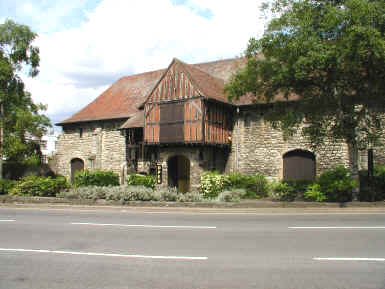The Medieval Church
The medieval church played a very dominant role in the lives of peasants and nobility alike. There is little evidence to suggest that there were many people who did not believe in God, Heaven and Hell. From a young age, the English would be taught that devoting oneself to the Roman Catholic Church was the only way to Heaven, and that Hell was a place to be avoided at all costs.
As a result of these strong beliefs, the church had complete control over the whole population. Peasants were even expected to work free of charge on the church land despite having a significant amount of work to do on the land they rented from their lord.The Poor Peasant
Peasants would also offer the church 10 per cent of their annual earnings, known as a tithe, which they would deliver in the form of either money or produce such as livestock or seeds. This seriously damaged their ability to be able to produce the maximum amount of crops or meat the following year. However, peasants were frequently warned that failure to pay this sum would lead to their souls going to Hell after death.

The Catholic Church had so much control over the population, including even the most poor, that it was became a target for Henry VIII, who wanted access to the funds it receive from across England.
Baptisms were also paid for as it was believed this sacrament, along with marriage and burial in holy land, was needed to allow entry into Heaven.
In addition to all the funds being paid to the church, the church itself was not required to pay taxes. This saved it a large amount of money and meant it had more wealth than even the royal family. This is reflected in the Church’s buildings, including cathedrals and monasteries, which were built to such a high standard that many remain in excellent condition today.
Most major cities would have contained a cathedral, some of the most well known being Canterbury and York. Canterbury Cathedral became particularly well known following the death of Thomas Becket, after which people would pilgrimage to the holy building.
Cathedrals would have been the largest buildings constructed during medieval times, even including royal palaces. This was to ensure they could be seen from miles around and provide a constant reminder of the power of the church.
Those who working on the construction of a cathedral were considered honoured and would be required to be a member of a guild. Only basic tools were used during construction making work difficult and sometimes dangerous, but the church stated that anyone who died while working on a cathedral or other holy building would go automatically enter Heaven.
Here is a list of some of the well-known medieval churches still in existence:
Notre-Dame Cathedral, Paris, France: Built in the 12th century, this iconic cathedral is one of the most famous medieval churches in the world. It was damaged by fire in 2019 but is currently undergoing restoration.
Canterbury Cathedral, Kent, England: This medieval cathedral was built in the 11th century and is the seat of the Archbishop of Canterbury, the leader of the Church of England.
St. Peter's Basilica, Vatican City: This impressive basilica is one of the largest churches in the world and was built in the 16th century on the site of an earlier church dating back to the 4th century.
Chartres Cathedral, Chartres, France: Built in the 12th century, this Gothic cathedral is known for its stunning stained glass windows and impressive flying buttresses.
Westminster Abbey, London, England: This famous church was built in the 11th century and is the site of numerous royal coronations, including that of Queen Elizabeth II.
Salisbury Cathedral, Wiltshire, England: This medieval cathedral is famous for its towering spire, which is the tallest in the UK.
Basilica of San Francesco, Assisi, Italy: Built in the 13th century, this basilica is famous for its frescoes by Giotto and other notable Italian artists.
Cologne Cathedral, Cologne, Germany: This Gothic cathedral took over 600 years to build and is known for its stunning stained glass windows and towering spires.
Santa Maria del Mar, Barcelona, Spain: This 14th-century Gothic church is known for its impressive proportions and stunning stained glass windows.
Siena Cathedral, Siena, Italy: This medieval cathedral is known for its ornate facade and stunning marble floors, which are decorated with intricate mosaics.
St. Mark's Basilica, Venice, Italy: Built in the 11th century, this Byzantine-style basilica is famous for its ornate mosaics and stunning gold decorations.
Duomo di Milano, Milan, Italy: This impressive cathedral is one of the largest churches in Italy and is known for its striking Gothic architecture.
St. Vitus Cathedral, Prague, Czech Republic: This Gothic cathedral was built in the 14th century and is famous for its impressive stained glass windows and intricate stone carvings.
Durham Cathedral, Durham, England: This medieval cathedral is known for its striking Romanesque architecture and impressive ribbed vaulting.
San Giovanni in Laterano, Rome, Italy: This impressive basilica is one of the oldest churches in Rome and is the official seat of the Bishop of Rome, also known as the Pope.
Sainte-Chapelle, Paris, France: Built in the 13th century, this Gothic chapel is known for its stunning stained glass windows, which depict scenes from the Bible.
Basilica of St. Francis of Assisi, Assisi, Italy: This basilica is known for its impressive collection of frescoes by Giotto and other notable Italian artists.
Church of the Holy Sepulchre, Jerusalem: This church is believed to be built on the site of Jesus' crucifixion and is considered one of the holiest sites in Christianity.
Santa Maria Novella, Florence, Italy: This medieval church is known for its impressive frescoes by famous Italian artists like Masaccio and Giotto.
Burgos Cathedral, Burgos, Spain: This impressive Gothic cathedral is known for its intricate stone carvings and stunning stained glass windows.
See also: Medieval Church Architecture
MLA Citation/Reference
"The Medieval Church". HistoryLearning.com. 2024. Web.
